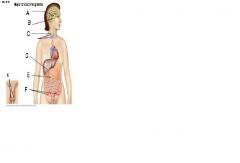![]()
![]()
![]()
Use LEFT and RIGHT arrow keys to navigate between flashcards;
Use UP and DOWN arrow keys to flip the card;
H to show hint;
A reads text to speech;
28 Cards in this Set
- Front
- Back
|
list the 5 types of chemcial signaling
|
endocrine, paracrine, autocrine, synaptic, neuroendocrine
|
|
|
what are the 3 improtant factors in the definition of a hormone
|
1.the chemcial signal is secreted into the blood or hemolymph
2. the chemcial is produced by cells or tissues in the body 3. the chemcial acts on specific target tissues |
|
|
describe the anatomy of an endocrine gland
|
highly vascularized, 1-2 layers of epithelial cells (except hypothalumus) ductless, usually in close proximity to their target tissue (form and function)
|
|
|
describe an ablation/ replacement experiment and how it demostrates what a hormone does
|
removed the gland responsible for the effect and observe what happens when the hormone isn't present. then replace the gland and see it the animal is"normal" again. be sure to include positive and negative controls
|
|
|
list the three major classes of hormones and the chemical composition that defines them
|
peptide hormones- amino acids
steroids- cholesterol ecosenoids- prostaglandins |
|
|
how are peptide hormones made?
|
they are derived from a string of amino acids like any protein and processed the the ER and glogi. they can be modified by glycosolation. They can then be stored in vesicles
|
|
|
how are peptide hormones controled
|
because they are water soluble, peptide hormones are controled based on secretion. they are stored in vesicles until they cell recelves the signal to release them
|
|
|
describe how steroid hormones are made
|
they are produced in the mitochondria where cholesterol is broken down into pregnenolone. they then proceed through a series of enzymatic reactions in the smooth ER. In cells that normally don't make steroids, peripheral activation can occur and the cell can use special enzymes to convert one hormone into another
|
|
|
Describe the anatomy of a steroid producing cell
|
lots of mitochondria and smooth ER, may have lipid droplets as sources of cholesterol
|
|
|
How are steroid hormones controlled
|
since steroids are fat solube, they can't be stored in a membrane. Instead they are controlled by production, they are not made until they are needed
|
|
|
given that peptide hormones are controlled by storage and steroid hormones are controlled by production, how does this effect the resposne time of each?
|
peptide hormone responses can occur quickly becase all that needs to happen is release. steroid responses take longer to take effect and tend to last longer because the hormone must first be manufactored
|
|
|
Besides control by production, how else might steroid hormones be controlled?
|
they can be controlled by the concentration of transport proteins
|
|
|
Describe the role of transport proteins in relationship to steroid hormones
|
Transport proteins help the fat solube steroid hormones move through the aqueous environment of the blood. when the hormone is in complex with the protein, it is inactive, transport proteins also change the half life of the hormone which allows for storage
|
|
|
What hormone is derived from the amino acid tryptophan
|
melatonin
|
|
|
What hormone classes are derived from the amino acid tyrosine
|
catecholamines and thyroid hormones
|
|
|
Give two examples of catecholamines
|
epinepherine and norepinepherine
|
|
|
Give two examples of thyroid hormones
|
thyroxine and triiodothronine
|
|
|
What type of receptors to water solube hormones bind to? Why?
|
water solube hormones bind to receptors on the cell surface because they cannont penetrate the hydophillic inside of the lipid bilayer membrane
|
|
|
What type of receptors do lipid soluble hormones bind to
|
fat soluble hormones bind to intracellualr receptors. they can serve as transcription factors
|
|
|
Describe an experiment that could help determine what the target tissue of a hormone is
|
Radiolabel the hormone and figure out which tissue it accumulates in after the initial effect of the distribution throughout the bloodstream disappears (tissues that are highly vascularized will show an initial peak)
|
|
|
What are the benefits of second messengers in hormone signaling
|
amplification of the signal, rapid response, and easy to turn off (transient)
|
|
|
When attempting to measurethe response to a peptide hormone what can you measure? steroid?
|
you can measure the activation of second messengers
steroid- measure mRNA |
|
|
what are some advantages of steroid hormone intracelluar receptors/ regulation of gene expression
|
the gene expression itself is change along with the chemical composition of the cell, gene networks are altered, leads to long term changes (hours to days)
|
|

Label all the endocrine glands and briefly describe their role
|
A= hypothalamus- coordinates nervous and endocrine control, close to nervous system
B= pituitary C= thyroid, parathyroid- not near stimulus or target but near blood huge blood vessel D= adrenal – controls ion metabolism, acts on kidney and liver E= pancreas- controls glucose metabolism, near stomach and small intestine F= ovaries- reproductive function, near reproductive organs G= testes “” |
|
|
compare hormones vs. neurohormones vs. neurotransmitters based on where they are released from
|
hormones- released by endocrine tissue
neurohormone- released by neurons neurotransmitter- released by presynaptic nerve ending |
|
|
compare hormones vs. neurohormones vs. neurotransmitters based on where they are released to
|
hormone- bloodstream
neurohormone- exerts hormonal effects ouside nervous system neurotransmitter- receptor in post synaptic membrane |
|
|
define agonist
|
a substance that mimics the action of the hormone and can engage the receptor
|
|
|
define antagonist
|
a substance that inhibits, blocks, or counteracts the effects of the hormone binding to the receptor
|

